Pitta
| Pitta | |
|---|---|
 | |
| Hooded pitta | |
| Scientific classification | |
| Kingdom: | Animalia |
| Phylum: | Chordata |
| Class: | Aves |
| Order: | Passeriformes |
| Suborder: | Tyranni |
| Infraorder: | Eurylaimides |
| Superfamily: | Pittoidea Swainson, 1831 |
| Family: | Pittidae Swainson, 1831 |
| Genera | |
Pittas are a family, Pittidae, of passerine birds mainly found in tropical Asia and Australasia, although a couple of species live in Africa. Pittas are all similar in general structure and habits, and have often been placed in a single genus, although as of 2009 they are now split into three genera, Pitta, Erythropitta and Hydrornis. The name is derived from the word pitta in the Telugu language of South India and is a generic local name used for all small birds. Pittas are medium-sized by passerine standards, at 15 to 25 cm (5.9–9.8 in) in length, and stocky, with strong, longish legs and long feet. They have very short tails and stout, slightly decurved bills. Many, but not all, have brightly coloured plumage.[1]
These are fairly terrestrial birds of wet forest floors. They eat snails, insects and similar invertebrate prey. Pittas are mostly solitary and lay up to six eggs in a large spherical nest in a tree or shrub, or sometimes on the ground. Both parents care for the young.[1] Many species of pittas are migratory, and they often end up in unexpected places like house-gardens during migration.
Many species of pitta are threatened with extinction. Four of these are listed as endangered by the IUCN; a further nine species are listed as vulnerable and several more are near-threatened. The main threat to pittas is habitat loss in the form of rapid deforestation.
Taxonomy and systematics
Pittas were first described scientifically by Carl Linnaeus in 1766 in his revised 12th edition of the Systema Naturae. He placed the Indian pitta in the crow family and genus Corvus. Ten years later it was placed in the thrush family, due to similarities of morphology and behaviour, before being placed in its own genus, Pitta in 1816 by Louis Vieillot. Vieillot was also the first to consider the genus a family in its own right.[2] The family's closest relatives have for a long time assumed to be the other suboscine birds, and particularly the Old World broadbills and asities (formerly treated as two families, now either lumped into one or split into four). A 2006 study confirmed that these were the closest relatives of the pittas.[3]
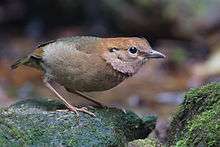
The number of pitta genera has varied considerably, ranging from one to as many as nine. In his 1863 work A Monograph of the Pittidae Daniel Elliot split the pittas into two genera, Pitta for the species with comparatively long tails and Brachyurus for the shorter tailed species. Barely two decades later, in 1880/81, John Gould split the family into nine genera, to which he also included the lesser melampitta (Melampitta), where it was kept until 1931 when Ernst Mayr demonstrated it had the syrinx was of an oscine bird.[4] Soon afterwards Philip Sclater's Catalogue of the Birds of the British Museum brought the number back down to three.
Modern treatments vary as well. A 1975 checklist included six genera, whereas the 2003 volume of the Handbook of the Birds of the World, which covered the family, placed all the pittas in a single genus.[2] The family was not well studied using modern anatomical or phylogenetic techniques; two studies, in 1987 and 1990, each used only four species, and comparisons amongst the family as a whole have relied mostly on external features and appearances.[3]
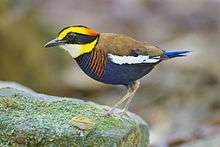
A 2006 study of the nuclear DNA of the pittas, using study skins from museums, was the first to examine most representatives of the family, and found evidence of three major clades of pitta. Based on the study it proposed splitting the pittas into three genera. The first clade, using the genus name Erythropitta, originally included six species (but see below) that had previously been considered closely related on external features. They are all generally small species with small tails, extensive amounts of crimson or red on the underparts, and greenish or blueish backs.[3] The second genus, Hydrornis, includes a number of variable Asian species. These species are unified morphologically in exhibiting sexual dimorphism in their plumage, as well as in possessing cryptic juvenile plumage (in all the species thus far studied). Into this second clade is included the eared pitta, which had often been placed into its own genus, Anthocincla, on account of its apparent primitive characteristics. The third genus, Pitta, is the most widespread clade. Most species in this genus have green upperparts with a blue wing-patch, dark upperparts and cinnamon-buff underparts. This clade contains all the migratory species of pitta, and it is thought that many of the pitta species from islands are derived from migratory species.[3] This division of the pittas into three genera has been adopted by the International Ornithological Congress' (IOC) Birds of the World: Recommended English Names.[5]
As with genera, there has been considerable variation in the number of recorded pitta species. The checklists of Sclater and Elliot at the end of the 19th century contained 48 and 47 species each. More recent checklists have had fewer than this, one listing just 24 species. Since the 1990s the figure has been between 30 and 32 species; the 2003 Handbook of the Birds of the World recognises 30. One species not recognised by the Handbook is the black-crowned pitta, which is treated as a subspecies of either the garnet pitta or the graceful pitta.[2] Since the puplication of the handbook more splits have occurred; in 2010 the banded pitta was split into three species, one endemic to Java and Bali, one endemic to Borneo and one found in Sumatra and the Thai-Malay Peninsula.[6] A 2013 study found that the red-bellied pitta, a widespread species found from Sulawesi to Australia, was actually a species complex. The study divided the species into 17 new species,[7] although authorities like the IOC have recognised only 10.[5]
Description
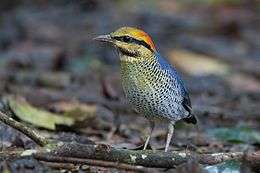
The pittas are small to medium-sized passerines, ranging in size from the blue-banded pitta at 15 cm (5.9 in) to the giant pitta, which can be up to 29 cm (11 in) in length. In weight they range from 42 to 210 g (1.5–7.4 oz). Pittas are stout bodied birds with long, strong tarsi (lower leg bones) and long feet. There is considerable variation in the colour of the legs and feet, this may be used by females in judging the quality of males. The wings have ten primaries are generally rounded and short; those of the four migratory species, however, are more pointed. Although pittas are behaviourally reluctant to fly, they are capable and even strong fliers. The tails range from being short to very short, and is composed of twelve feathers.[2][8] They have a keen sense of smell, and have the largest olfactory ratio (ratio of the olfactory bulb to the rest of the brain) of any passerine examined.[2][9]
Atypically for forest floor species, the plumage of pittas is often bright and colourful. Only one species, the eared pitta, has entirely cryptic colours in the adults of both sexes. In the same genus, Hydrornis, are three further species with quite drabber than average plumage, the blue-naped pitta, blue-rumped pitta and rusty-naped pitta. Like the other Hydrornis pittas they are sexually dimorphic in their plumage, with the females tending towards being drabber and more cryptic than the males. Across most of the family the brighter colours tend to be on the undersides, with the bright colours on the rump, wings and uppertail coverts being concealable. Being able to conceal bright colours from above is important as most predators approach from above.[2]
Distribution and habitat
The pittas are generally birds of tropical forests, semi-forests and scrub. Most species need forests with lots of cover, a rich understory, and leaf litter for feeding, and they are often found near waterways as well. Some species inhabit swamps and bamboos forests,[2] and the mangrove pitta, as its name suggests, is a mangrove specialist.[10] A number of species are lowland forest specialists, for example the rainbow pitta is not found above 400 m (1,300 ft), whereas other species may occur at much higher elevations, for example rusty-naped pittas have been found up to 2,600 m (8,500 ft). This varies in the fairy pitta across its range, reaching up to 1,300 m (4,300 ft) in Taiwan but at much lower levels in Japan.[2] In addition to natural habitats pittas may use human altered habitats, for example migrating blue-winged pittas and hooded pittas use parks and urban gardens in Singapore.[10]
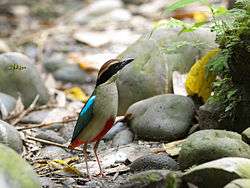
The greatest diversity of pittas are found in South-east Asia. Of the three genera, the large genus Pitta is the most widespread. The two species found in Africa are from this clade, as are the most northerly species (the fairy pitta) and the most southerly (the noisy pitta). The most remote insular endemics are in this group as well, including the black-faced pitta, which is endemic to the Solomon Islands. The pittas of the clade Erythropitta are mostly found in Asia with one species, the Papuan pitta, reaching the north of Australia. The Hydrornis pittas are exclusively Asian.[2][3] Some pittas have large distributions, like the hooded pitta, which ranges from Nepal to New Guinea, others have much smaller ones, like the superb pitta, which is endemic to the tiny island of Manus in the Admiralty Islands.[2][11]
The movements of pittas are poorly known and notoriously difficult to study.[12] Bird ringing studies have not shed much light on this, one study in the Philippines ringed 2000 red-bellied pittas but only recaptured ten birds, and only one of these recaptures was more than two months after the initial capture. Only four species of pitta are fully or mostly migratory, all in the genus Pitta, the Indian pitta, African pitta, fairy pitta and blue-winged pitta. In addition to these four the northern subspecies of the hooded pitta (cucullata) is a full migrant. Other species make smaller or more local, and poorly understood, movements across small parts of their range,[2] for example the noisy pitta of Australia.[13] The migration of pittas is apparently nocturnal, and pittas migrate in small loose flocks which use the same resting and foraging sites each year.[14]
Behaviour and ecology
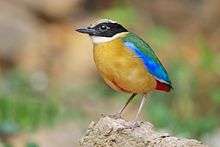 |
Blue-winged pitta call
The call of the blue-winged pitta |
| Problems playing this file? See media help. | |
Pittas are diurnal, requiring light in order to find their often cryptic prey. They are nevertheless often found in darker areas and are highly secretive, though they will respond to imitations of their calls. They are generally found as single birds, with even young birds not associating with their parents unless they are being fed. Small groups have been observed during migration.[2]
The pittas are strongly territorial, with territories varying in size from 3000 m² in the African pitta to 10,000m² in the rainbow pitta.[14] Pittas will perform territory defence displays on the edges of their territories, although fights between rivals have only been recorded once. One such territorial display is given by the rainbow pitta, which holds its legs straight and bows to a rival on the edge of territory, while making a purring call. Displays like this are paired with calls made out of sight of potential rivals;[15] these territorial calls are frequent and can account for up to 12% of a bird's daylight activity.[16] Migratory species will defend non-breeding feeding territories in addition to their breeding ones.[2]
Diet and feeding

Earthworms form the major part of the diet of pittas, followed by snails in order of importance. Earthworms may however become seasonally unavailable in dry conditions when the worms move deeper into the soil. In addition a wide range of invertebrate prey is eaten, including many insects groups such as termites, ants, beetles, true bugs, and lepidopterans; as well as freshwater crabs, centipedes, millipedes, and spiders.[2] In addition to invertebrates some species, such as the fairy pitta and rainbow pitta, have been recorded feeding on vertebrate prey. These include skinks, frogs, snakes and, in the case of the fairy pitta, shrews.[2][17]
Pittas feed in a thrush-like fashion, moving aside leaves with a sweeping motion of the bill. They have also been observed to probe the moist soil with their bills in order to locate earthworms. It has been suggested that they are able to locate earthworms by smell; a suggestion supported by a study which found that they have the largest olfactory bulb of 25 passerines examined.[18] Some species will also use tree roots and rocks as anvils on which to smash open snails in order to eat.[19]
Breeding
Like most birds the pittas are monogamous breeders, and defend breeding territories. Most species are seasonal breeders, timing their breeding to occur at the onset of the rainy season.[2][20] An exception to this is the superb pitta, which breeds almost year-round, as the island of Manus which it breeds on remains wet all year. The courtship behaviours of the family are poorly known, but the elaborate dance of the African pitta includes jumping into the air with a puffed out breast and parachuting down back down to the perch.[2]
.jpg)
The pittas build a rudimentary nest that is a dome with a side entrance. The structure of the nest is consistent across the whole family. The nest is as large as a rugby ball, and is usually well camouflaged amongst vines or vegetation of some kind. The nest's appearance is also difficult to distinguish from a heap of leaves pushed together by the wind,[2] although a few species created a "doormat" of sticks (sometimes decorated with mammal dung)[21] by the entrance. The nests can either be placed on the ground or in trees. Some species always nest in trees, like both African species, others nest only on the ground, and others show considerable variation. Both sexes help to build the nest, but the male does most of the work. It takes around two to eight days to build a new nest; this probably varies depending on the experience of the birds involved. A new nest is constructed for each nesting attempt, [2] and work on building a nest for s second brood may start while the chicks from the first brood are still being fed.[22]
_Photograph_by_Shantanu_Kuveskar.jpg)
The clutch size varies by species. Typically three to five eggs are laid, but two is typical for the garnet pitta, whereas six is more common for the blue-winged pitta and the Indian pitta.[2] It is thought that species with higher levels of predation tend to have smaller clutches, as smaller clutches involve fewer provisioning trips that might alert a predator to the presence of a nest, and the loss of a smaller clutch is less costly to replace.[22] Clutch size may vary within a species depending on latitude. A study of noisy pitta found that birds in the tropics had smaller clutch sizes than those in more temperate environments.[20] The eggs of pittas are ovoid, with one end slightly pointed, and generally smooth (the deeply pitted eggs of the superb pitta being the exception to this). The size of eggs varies by species, with smaller species laying smaller eggs. There is also some variation in egg size within a species in species with large ranges. For example, the eggs of noisy pittas are smaller closer to the tropics.[2] Eggs are typically white or creamy, and usually slightly glossy.[23]
Both parents incubate the clutch, the period between laying and hatching being between 14 and 18 days (14 to 16 being more typical). The chicks usually hatch asynchronously, over a number of days, but in some species the hatching is synchronous. On hatching the parents of at least two species are reported to consume the eggshells. The behaviour ensures that the calcium used to create the eggs is not lost. It is not known if other species do this, but it is a common behaviour in the bird world. As with the incubation period both parents participate in rearing the chicks. The chicks of pittas are entirely altricial, hatching both naked and blind, and dependent upon their parents for warmth, food and nest sanitation. Young chicks are brooded continuously, with the female brooding during the night and the duties being shared during the day. The males and females make regular feeding trips to the chicks;[2] one study of Gurney's pittas found a pair made 2300 feeding visits to the nest, traveling an estimated 460 km (290 mi) over the nestling stage.[24] Earthworms are important food items for many species, and the dominant item in the nestling diet of some. 73% of the parental visits of fairy pittas, 63% in rainbow pittas, up to 79% in Gurney's pittas are with earthworms. Parents can and do carry more than one item in their bills during visits; in a study of breeding fairy pittas as many as six items could be brought in a single visit, although less than four was typical.[17] When the chicks are small prey may be broken up prior to being fed to the chicks,[2] and larger prey items like skins and snakes are only fed to the older chicks able to manage them.[17]
Relationship with humans
The brilliant plumage of many pittas has resulted in considerable interest in pittas from people living within their range, scientists, aviculturists and birdwatchers, and has led to their alternative name "jewel-thrushes". Such is their attractiveness that in Borneo even the body of a dead pitta can be a favoured toy for local children. They have proven difficult to maintain and breed in captivity, requiring large amounts of space, humidity and sufficient vegetation of the right kind.[2] Pittas are a very popular group of birds with birdwatchers, due to the dazzling plumage of many species and the relative difficulty of seeing these retiring birds in dark forests.[2] Their desirability as birdwatching targets was the subject of The Jewel Hunter where writer Chris Goodie attempted to see every species of pitta.[25]
Status and conservation
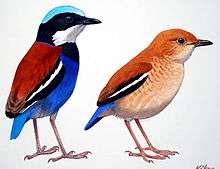
Pittas are generally forest birds and as such are vulnerable to habitat loss caused by rapid deforestation.[2] They can also be difficult birds to survey and are easily overlooked.[26] Four species are assessed to be endangered, and a further nine are listed as vulnerable by the International Union for Conservation of Nature. Additionally eight species are listed as near-threatened and one, the Louisiade pitta, is too poorly known to be assessed and is listed as data deficient.[27] The Gurney's pitta was not seen for 34 years between 1952 and 1986, before a small population was discovered in southern Thailand.[28] This small population continued to decline since its rediscovery, and by 2000 it had reached a low of 10 pairs, and was listed as critically endangered. In 2003 the species was found in Burma for the first time since 1914, and in large numbers, between nine and thirty five thousand pairs. Although the species was considerably less threatened than thought, it is still of considerable conservation concern as deforestation of the habitat in Burma continues.[26] The rapid rate of deforestation in Borneo has pushed the blue-headed pitta, previously considered common and secure as recently as 1996, into the list of species considered vulnerable.[29] Pittas have also been targeted by poachers for the illegal wild bird trade. They are not targeted because of their song, as many songbirds are, and may simply be captured as bycatch from collecting other species, and because of their attractive plumage. According to some trappers they also may end up being eaten for food.[30] On Manus, locals report that predation by snakes, including the brown tree snake, is responsbile for the rarity of the endangered superb pitta,[31] but the snake, which is responsible for a number of extinctions across the Pacific, is native to the island.[11]
Species of pitta

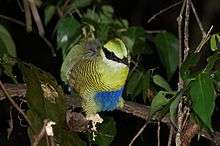
- Eared pitta, Hydrornis phayrei
- Blue-naped pitta, Hydrornis nipalensis
- Blue-rumped pitta, Hydrornis soror
- Rusty-naped pitta, Hydrornis oatesi
- Schneider's pitta, Hydrornis schneideri
- Giant pitta, Hydrornis caerulea
- Blue-headed pitta, Hydrornis baudii
- Blue pitta, Hydrornis cyanea
- Bar-bellied pitta, Hydrornis elliotii
- Javan banded pitta, Hydrornis guajana
- Malayan banded pitta, Hydrornis irena
- Bornean banded pitta, Hydrornis schwaneri
- Gurney's pitta, Hydrornis gurneyi
- Whiskered pitta, Erythropitta kochi
- Philippine pitta, Erythropitta erythrogaster
- Sula pitta, Erythropitta dohertyi
- Sulawesi pitta, Erythropitta celebensis
- Siao pitta, Erythropitta palliceps
- Sangihe pitta, Erythropitta caeruleitorques
- South Moluccan pitta, Erythropitta rubrinucha
- North Moluccan pitta, Erythropitta rufiventris
- Louisiade pitta, Erythropitta meeki
- Bismarck pitta, Erythropitta novaehibernicae
- Papuan pitta, Erythropitta macklotii
- Blue-banded pitta, Erythropitta arcuata
- Garnet pitta, Erythropitta granatina
- Black-crowned pitta, Erythropitta ussheri
- Graceful pitta, Erythropitta venusta
- Hooded pitta, Pitta sordida
- Ivory-breasted pitta, Pitta maxima
- Superb pitta, Pitta superba
- Azure-breasted pitta, Pitta steerii
- African pitta, Pitta angolensis
- Green-breasted pitta, Pitta reichenowi
- Indian pitta, Pitta brachyura
- Fairy pitta, Pitta nympha
- Blue-winged pitta, Pitta moluccensis
- Mangrove pitta, Pitta megarhyncha
- Elegant pitta, Pitta elegans
- Noisy pitta, Pitta versicolor
- Black-faced pitta, Pitta anerythra
- Rainbow pitta, Pitta iris
References
- 1 2 McClure, H. Elliott (1991). Forshaw, Joseph, ed. Encyclopaedia of Animals: Birds. London: Merehurst Press. pp. 159–160. ISBN 1-85391-186-0.
- 1 2 3 4 5 6 7 8 9 10 11 12 13 14 15 16 17 18 19 20 21 22 23 24 25 26 Erritzoe, J (2017). del Hoyo, Josep; Elliott, Andrew; Sargatal, Jordi; Christie, David A.; de Juana, Eduardo, eds. "Family Pittidae (Pittas)". Handbook of the Birds of the World Alive. Barcelona, Spain: Lynx Edicions. Retrieved 11 July 2017. (Subscription required (help)).
- 1 2 3 4 5 Irestedt, M., Ohlson, J. I., Zuccon, D., Källersjö, M. & Ericson, P. G. P. (2006). "Nuclear DNA from old collections of avian study skins reveals the evolutionary history of the Old World suboscines (Aves: Passeriformes)" (PDF). Zoologica Scripta. 35: 567–580. doi:10.1111/j.1463-6409.2006.00249.x.
- ↑ Mayr, Ernst (1931). "Die Syrinx einiger Singvögel aus Neu-Guinea" (PDF). Journal für Ornithologie (in German). 79 (3): 333–337. doi:10.1007/bf01953006.
- 1 2 Gill, Frank; D Donsker (2010). "NZ Wrens to Ovenbirds". IOC World Bird Names (version 2.7). International Ornithological Congress. Retrieved 23 January 2011.
- ↑ Rheindt, Frank; James Easton (2010). "Biological species limits in the Banded Pitta Pitta guajana" (PDF). Forktail. 26: 86–91.
- ↑ Irestedt, M.; Fabre, P.; Batalha-Filho, H.; Jønsson, K.; Roselaar, C.; Sangster, G.; Ericson, P. (2013). "The spatio-temporal colonization and diversification across the Indo-Pacific by a ‘great speciator’ (Aves, Erythropitta erythrogaster)". Proceedings of the Royal Society B. 280 (1759). doi:10.1098/rspb.2013.0309.
- ↑ Whitehead, John (1893). "A Review of the Species of the Family Pittidae". Ibis. 35 (4): 488–509. doi:10.1111/j.1474-919X.1893.tb01238.x.
- ↑ Cobb, Stanley (1968). "The Size of the Olfactory Bulb in 108 Species of Birds" (PDF). The Auk. 85 (1): 55–61. doi:10.2307/4083624.
- 1 2 Lok, A; Khor, K; Lim, K; R Subaraj (2009). "Pittas (Pittidae) of Singapore" (PDF). Nature in Singapore. 2: 155–165.
- 1 2 BirdLife International. "Species factsheet: Pitta superba". Data Zone. BirdLife International. Retrieved 24 January 2011.
- ↑ "Pittas of Thailand". Thai Birding. Retrieved 4 June 2011.
- ↑ Woodall, P. F. (1994). "Breeding Season and Clutch Size of the Noisy Pitta in Tropical and Subtropical Australia". Emu. 94 (4): 273. doi:10.1071/MU9940273.
- 1 2 Erritzoe (1998), p. 22
- ↑ Zimmerman, Udo (1995). "Displays and Postures of the Rainbow Pitta and other Australian Pittas". Australian Bird Watcher. 16 (4): 161–164. (Subscription required (help)).
- ↑ Higgins, P. J.; Peter, J. M.; Steele, W. K., eds. (2001). Handbook of Australian, New Zealand and Antarctic Birds. Volume 5: Tyrant-flycatchers to Chats. Melbourne: Oxford University Press. pp. 117–125. ISBN 0-19-553258-9.
- 1 2 3 Lin, Ruey-Shing; Yao, Cheng-Te; Pei-Fen Lee (2007). "The Diet of Fairy Pitta Pitta nympha Nestlings in Taiwan as Revealed by Videotaping" (PDF). Zoological Studies. 46 (3): 355–361.
- ↑ Bang, B.G.; Stanley Cobb (1968). "The Size of the Olfactory Bulb in 108 Species of Birds". The Auk. 85 (1): 55–61. doi:10.2307/4083624.
- ↑ Woinarski, J.C.W; A. Fisher; K. Brennan; I. Morris; R.C. Willan; R. Chatto (1998). "The Chestnut Rail Eulabeornis castaneoventris on the Wessel and English Company Islands: Notes on Unusual Habitat and Use of Anvils". Emu. 98 (1): 74–78. doi:10.1071/MU98007E.
- 1 2 Woodall, P.F. (1994). "Breeding Season and Clutch Size of the Noisy Pitta Pitta versicolor in Tropical and Subtropical Australia". Emu. 94 (4): 273–277. doi:10.1071/MU9940273.
- ↑ Zimmerman, Udo; Noske, Richard (2004). "Why Do Rainbow Pittas Pitta iris Place Wallaby Dung at the Entrance to Their Nests?". Australian Field Ornithology. 21 (4): 163–165. (Subscription required (help)).
- 1 2 Zimmermann, Udo M.; Noske, Richard A. (2003). "Breeding biology of the Rainbow Pitta, Pitta iris, a species endemic to Australian monsoon-tropical rainforests" (PDF). EMU. 103 (3): 245–254. doi:10.1071/MU02005.
- ↑ Erritzoe (1998), p. 26
- ↑ Erritzoe (1998), p. 27
- ↑ GrrlScientist (28 February 2011). "The Jewel Hunter [Book Review]". Guardian. Retrieved 18 July 2017.
- 1 2 Donald, P. F.; Aratrakorn, S.; Win Htun, T.; Eames, J. C.; Hla, H.; Thunhikorn, S.; Sribua-Rod, K.; Tinun, P.; Aung, S. M.; Zaw, S. M.; Buchanan, G. M. (2009). "Population, distribution, habitat use and breeding of Gurney's Pitta Pitta gurneyi in Myanmar and Thailand" (PDF). Bird Conservation International. 19 (04): 353–366. doi:10.1017/S0959270909008612.
- ↑ BirdLife International (2017). "Family Pittidae". Data Zone. Retrieved 17 July 2017.
- ↑ Gretton, Adam; Kohler, Marcus; Lansdown, Richard V.; Pankhurst, Tim J.; Parr, John; Robson, Craig (1993). "The status of Gurney's Pitta Pitta gumeyi, 1987–1989" (PDF). Bird Conservation International. 3 (04): 351–367. doi:10.1017/S0959270900002604.
- ↑ BirdLife International (2001). "Blue-headed Pitta". Threatened birds of Asia: the BirdLife International Red Data Book. Cambridge, UK: BirdLife International. Retrieved 2 August 2010.
- ↑ Shepherd, Chris; Eaton, James; Serene, Chng (2015). "Pittas for a pittance: observations on the little known illegal trade in Pittidae in west Indonesia" (PDF). Birding Asia. 24: 18–20.
- ↑ Dutson, Guy C. L.; Newman, Jonathan L. (1991). "Observations on the Superb Pitta Pitta superba and other Manus endemics". Bird Conservation International. 1 (03): 215–222. doi:10.1017/S0959270900000605.
Cited text
- Erritzoe, L.; Erritzoe, H. (1998). Pittas of the World, A Monograph of the Pitta Family. Cambridge: Lutterworth Press. ISBN 0-7188-2961-1.
External links
| Wikimedia Commons has media related to Pitta. |
| Wikispecies has information related to: Pitta |
- Pitta videos on the Internet Bird Collection